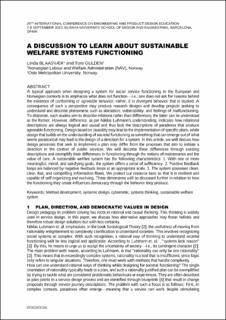| dc.description.abstract | A typical approach when designing a system for social service functioning in the European and Norwegian contexts is to emphasize what does not function—i.e., one does not ask for reasons behind the existence of conforming or agreeable behavior; rather, it is divergent behavior that is studied. A consequence of such a perspective may produce research designs and develop projects seeking to understand and describe phenomena such as alienation, vulnerability, and feelings of malfunctioning. To elaborate, such studies aim to describe relations rather than differences; the latter can be understood as the former. However, difference, as per Niklas Luhmann's understanding, indicates how relational descriptions are always logical and causal and thus lack the descriptions of paradoxes that produce agreeable functioning. Design based on causality may lead to the implementation of specific plans, while design that builds on the understanding of societal functioning as something that can emerge out of what seems paradoxical may lead to the design of a direction for a system. In this article, we will discuss how design processes that seek to implement a plan may differ from the processes that aim to initiate a direction in the context of public services. We will describe these differences through existing descriptions and exemplify their differences in functioning through the notions of maintenance and the value of care. A sustainable welfare system has the following characteristics: 1. With one or more meaningful, moral, and satisfying goals, the system offers a sense of sufficiency. 2. Positive feedback loops are balanced by negative feedback loops at an appropriate scale. 3. The system possesses clean, clear, fast, and compelling information flows. We protect our resource base so that it is resilient and capable of self-organizing and evolving. These dimensions will be discussed further in relation to how the functioning they create influences democracy through the behavior they produce. | en_US |

